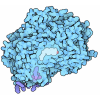[English] 日本語
 Yorodumi
Yorodumi- PDB-7k65: Hedgehog receptor Patched (PTCH1) in complex with conformation se... -
+ Open data
Open data
- Basic information
Basic information
| Entry | Database: PDB / ID: 7k65 | ||||||||||||
|---|---|---|---|---|---|---|---|---|---|---|---|---|---|
| Title | Hedgehog receptor Patched (PTCH1) in complex with conformation selective nanobody TI23 | ||||||||||||
 Components Components |
| ||||||||||||
 Keywords Keywords | MEMBRANE PROTEIN | ||||||||||||
| Function / homology |  Function and homology information Function and homology informationLigand-receptor interactions / Activation of SMO / neural plate axis specification / cell differentiation involved in kidney development / hedgehog receptor activity / response to chlorate / cell proliferation involved in metanephros development / smoothened binding / neural tube formation / hedgehog family protein binding ...Ligand-receptor interactions / Activation of SMO / neural plate axis specification / cell differentiation involved in kidney development / hedgehog receptor activity / response to chlorate / cell proliferation involved in metanephros development / smoothened binding / neural tube formation / hedgehog family protein binding / hindlimb morphogenesis / Hedgehog 'on' state / epidermal cell fate specification / spinal cord motor neuron differentiation / prostate gland development / Hedgehog 'off' state / somite development / patched binding / negative regulation of cell division / cellular response to cholesterol / dorsal/ventral neural tube patterning / smooth muscle tissue development / pattern specification process / pharyngeal system development / mammary gland epithelial cell differentiation / mammary gland duct morphogenesis / mammary gland development / cell fate determination / commissural neuron axon guidance / metanephric collecting duct development / dorsal/ventral pattern formation / regulation of growth / embryonic limb morphogenesis / negative regulation of multicellular organism growth / branching involved in ureteric bud morphogenesis / cholesterol binding / positive regulation of epidermal cell differentiation / dendritic growth cone / keratinocyte proliferation / spermatid development / positive regulation of cholesterol efflux / epidermis development / negative regulation of keratinocyte proliferation / negative regulation of osteoblast differentiation / embryonic organ development / axonal growth cone / negative regulation of smoothened signaling pathway / heart morphogenesis / response to mechanical stimulus / response to retinoic acid / negative regulation of stem cell proliferation / regulation of mitotic cell cycle / cyclin binding / epithelial cell proliferation / stem cell proliferation / neural tube closure / caveola / protein localization to plasma membrane / liver regeneration / animal organ morphogenesis / brain development / protein processing / cilium / regulation of protein localization / negative regulation of epithelial cell proliferation / apical part of cell / response to estradiol / glucose homeostasis / heparin binding / regulation of cell population proliferation / midbody / in utero embryonic development / response to xenobiotic stimulus / negative regulation of cell population proliferation / negative regulation of DNA-templated transcription / protein-containing complex binding / positive regulation of DNA-templated transcription / perinuclear region of cytoplasm / Golgi apparatus / negative regulation of transcription by RNA polymerase II / signal transduction / zinc ion binding / extracellular region / plasma membrane Similarity search - Function | ||||||||||||
| Biological species |   | ||||||||||||
| Method | ELECTRON MICROSCOPY / single particle reconstruction / cryo EM / Resolution: 3.4 Å | ||||||||||||
 Authors Authors | Zhang, Y. / Bulkley, D.P. / Liang, J. / Manglik, A. / Cheng, Y. / Beachy, P.A. | ||||||||||||
| Funding support |  United States, 3items United States, 3items
| ||||||||||||
 Citation Citation |  Journal: Proc Natl Acad Sci U S A / Year: 2020 Journal: Proc Natl Acad Sci U S A / Year: 2020Title: Hedgehog pathway activation through nanobody-mediated conformational blockade of the Patched sterol conduit. Authors: Yunxiao Zhang / Wan-Jin Lu / David P Bulkley / Jiahao Liang / Arthur Ralko / Shuo Han / Kelsey J Roberts / Anping Li / Wonhwa Cho / Yifan Cheng / Aashish Manglik / Philip A Beachy /  Abstract: Activation of the Hedgehog pathway may have therapeutic value for improved bone healing, taste receptor cell regeneration, and alleviation of colitis or other conditions. Systemic pathway activation, ...Activation of the Hedgehog pathway may have therapeutic value for improved bone healing, taste receptor cell regeneration, and alleviation of colitis or other conditions. Systemic pathway activation, however, may be detrimental, and agents amenable to tissue targeting for therapeutic application have been lacking. We have developed an agonist, a conformation-specific nanobody against the Hedgehog receptor Patched1 (PTCH1). This nanobody potently activates the Hedgehog pathway in vitro and in vivo by stabilizing an alternative conformation of a Patched1 "switch helix," as revealed by our cryogenic electron microscopy structure. Nanobody-binding likely traps Patched in one stage of its transport cycle, thus preventing substrate movement through the Patched1 sterol conduit. Unlike the native Hedgehog ligand, this nanobody does not require lipid modifications for its activity, facilitating mechanistic studies of Hedgehog pathway activation and the engineering of pathway activating agents for therapeutic use. Our conformation-selective nanobody approach may be generally applicable to the study of other PTCH1 homologs. | ||||||||||||
| History |
|
- Structure visualization
Structure visualization
| Movie |
 Movie viewer Movie viewer |
|---|---|
| Structure viewer | Molecule:  Molmil Molmil Jmol/JSmol Jmol/JSmol |
- Downloads & links
Downloads & links
- Download
Download
| PDBx/mmCIF format |  7k65.cif.gz 7k65.cif.gz | 215.9 KB | Display |  PDBx/mmCIF format PDBx/mmCIF format |
|---|---|---|---|---|
| PDB format |  pdb7k65.ent.gz pdb7k65.ent.gz | 168.6 KB | Display |  PDB format PDB format |
| PDBx/mmJSON format |  7k65.json.gz 7k65.json.gz | Tree view |  PDBx/mmJSON format PDBx/mmJSON format | |
| Others |  Other downloads Other downloads |
-Validation report
| Summary document |  7k65_validation.pdf.gz 7k65_validation.pdf.gz | 1.3 MB | Display |  wwPDB validaton report wwPDB validaton report |
|---|---|---|---|---|
| Full document |  7k65_full_validation.pdf.gz 7k65_full_validation.pdf.gz | 1.4 MB | Display | |
| Data in XML |  7k65_validation.xml.gz 7k65_validation.xml.gz | 44.2 KB | Display | |
| Data in CIF |  7k65_validation.cif.gz 7k65_validation.cif.gz | 63.4 KB | Display | |
| Arichive directory |  https://data.pdbj.org/pub/pdb/validation_reports/k6/7k65 https://data.pdbj.org/pub/pdb/validation_reports/k6/7k65 ftp://data.pdbj.org/pub/pdb/validation_reports/k6/7k65 ftp://data.pdbj.org/pub/pdb/validation_reports/k6/7k65 | HTTPS FTP |
-Related structure data
| Related structure data |  22689MC M: map data used to model this data C: citing same article ( |
|---|---|
| Similar structure data | |
| EM raw data |  EMPIAR-10328 (Title: Hedgehog receptor Patched (PTCH1) in complex with a conformation selective nanobody TI23 EMPIAR-10328 (Title: Hedgehog receptor Patched (PTCH1) in complex with a conformation selective nanobody TI23Data size: 75.2 Data #1: Particle stack of Hedgehog receptor PTCH1 in complex with nanobody TI23 for final reconstruction [picked particles - multiframe - processed]) |
- Links
Links
- Assembly
Assembly
| Deposited unit | 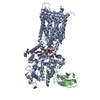
|
|---|---|
| 1 |
|
- Components
Components
| #1: Protein | Mass: 142619.938 Da / Num. of mol.: 1 Source method: isolated from a genetically manipulated source Source: (gene. exp.)   Homo sapiens (human) / References: UniProt: Q61115 Homo sapiens (human) / References: UniProt: Q61115 | ||||
|---|---|---|---|---|---|
| #2: Antibody | Mass: 13821.417 Da / Num. of mol.: 1 Source method: isolated from a genetically manipulated source Source: (gene. exp.)  Production host:  | ||||
| #3: Polysaccharide | 2-acetamido-2-deoxy-beta-D-glucopyranose-(1-4)-2-acetamido-2-deoxy-beta-D-glucopyranose Source method: isolated from a genetically manipulated source | ||||
| #4: Sugar | ChemComp-NAG / #5: Chemical | ChemComp-Q7G / Has ligand of interest | N | |
-Experimental details
-Experiment
| Experiment | Method: ELECTRON MICROSCOPY |
|---|---|
| EM experiment | Aggregation state: PARTICLE / 3D reconstruction method: single particle reconstruction |
- Sample preparation
Sample preparation
| Component |
| ||||||||||||||||||||||||
|---|---|---|---|---|---|---|---|---|---|---|---|---|---|---|---|---|---|---|---|---|---|---|---|---|---|
| Molecular weight | Experimental value: NO | ||||||||||||||||||||||||
| Source (natural) |
| ||||||||||||||||||||||||
| Source (recombinant) |
| ||||||||||||||||||||||||
| Buffer solution | pH: 8 | ||||||||||||||||||||||||
| Buffer component |
| ||||||||||||||||||||||||
| Specimen | Conc.: 4.5 mg/ml / Embedding applied: NO / Shadowing applied: NO / Staining applied: NO / Vitrification applied: YES | ||||||||||||||||||||||||
| Specimen support | Grid type: Quantifoil | ||||||||||||||||||||||||
| Vitrification | Instrument: FEI VITROBOT MARK III / Cryogen name: ETHANE / Humidity: 100 % / Chamber temperature: 298 K |
- Electron microscopy imaging
Electron microscopy imaging
| Experimental equipment |  Model: Titan Krios / Image courtesy: FEI Company |
|---|---|
| Microscopy | Model: FEI TITAN KRIOS |
| Electron gun | Electron source:  FIELD EMISSION GUN / Accelerating voltage: 300 kV / Illumination mode: FLOOD BEAM FIELD EMISSION GUN / Accelerating voltage: 300 kV / Illumination mode: FLOOD BEAM |
| Electron lens | Mode: BRIGHT FIELD |
| Specimen holder | Cryogen: NITROGEN / Specimen holder model: FEI TITAN KRIOS AUTOGRID HOLDER |
| Image recording | Average exposure time: 12 sec. / Electron dose: 85.6 e/Å2 / Detector mode: SUPER-RESOLUTION / Film or detector model: GATAN K2 SUMMIT (4k x 4k) / Num. of real images: 7046 |
| Image scans | Width: 3838 / Height: 3710 / Movie frames/image: 60 |
- Processing
Processing
| EM software |
| ||||||||||||||||||||||||||||||||||||
|---|---|---|---|---|---|---|---|---|---|---|---|---|---|---|---|---|---|---|---|---|---|---|---|---|---|---|---|---|---|---|---|---|---|---|---|---|---|
| CTF correction | Type: PHASE FLIPPING AND AMPLITUDE CORRECTION | ||||||||||||||||||||||||||||||||||||
| Particle selection | Num. of particles selected: 3621265 Details: Particles were picked first using a Gaussian blob as the template and then were re-picked using the 2D classes generated from the first round. | ||||||||||||||||||||||||||||||||||||
| 3D reconstruction | Resolution: 3.4 Å / Resolution method: FSC 0.143 CUT-OFF / Num. of particles: 307652 / Algorithm: BACK PROJECTION / Num. of class averages: 1 / Symmetry type: POINT | ||||||||||||||||||||||||||||||||||||
| Atomic model building | Protocol: FLEXIBLE FIT / Space: REAL | ||||||||||||||||||||||||||||||||||||
| Atomic model building | PDB-ID: 6MG8 Pdb chain-ID: A | ||||||||||||||||||||||||||||||||||||
| Refinement | Stereochemistry target values: GeoStd + Monomer Library + CDL v1.2 | ||||||||||||||||||||||||||||||||||||
| Displacement parameters | Biso mean: 135.37 Å2 | ||||||||||||||||||||||||||||||||||||
| Refine LS restraints |
|
 Movie
Movie Controller
Controller


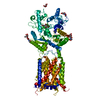
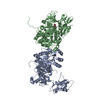
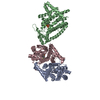
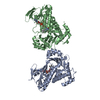
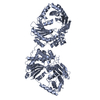


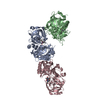
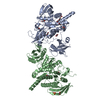
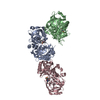
 PDBj
PDBj


